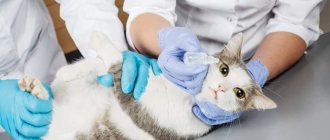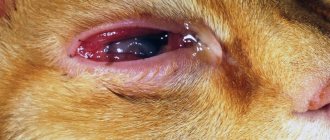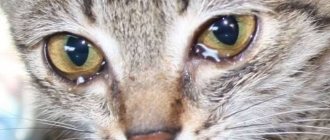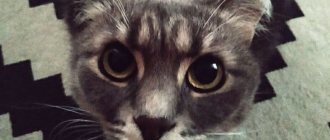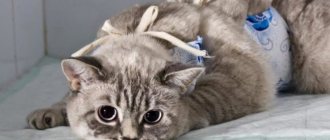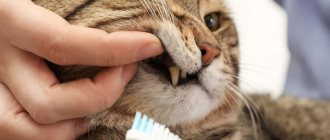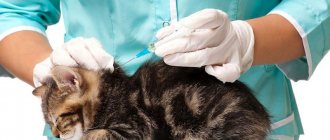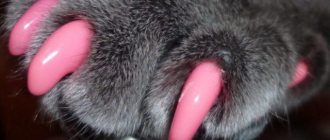Many cat lovers are faced with the issue of watery eyes. Moreover, a similar problem can occur in both adult cats and small kittens. In such cases, rinsing is required. This is a rather responsible procedure that requires accuracy and attentiveness. Otherwise, the opposite effect may occur.
You can wash your kitten's eyes only after consulting a veterinarian.
Causes of discharge from a kitten's eyes
Often the kitten requires additional care for its eyes; tears and mucus appear. Usually the cause of lacrimation is a weak immune system, and until the kitten receives all the necessary vaccinations, the owners will regularly encounter similar problems. The main reasons requiring additional intervention and consultation with a veterinarian are:
- Conjunctivitis. With this disease, an increase in body temperature is possible. A brown crust appears in the corners of the eyelids, and the secreted mucus acquires a yellowish tint.
- Injury to the cornea of the eye. When injured, the eyeball becomes inflamed and turns red.
- The allergy causes itching, the animal constantly rubs its eyelids.
- Infection of the body with worms. If the reason lies in parasites, then the animal does not have a fever. There is no redness or swelling of the eyes.
It is necessary to begin treatment for inflamed eyes as soon as possible, as this can lead to a decrease in visual acuity.
Preparation for procedures
Before washing your eyes, it is important to prepare the area, some tools, etc. The table is covered with a clean blanket, a diaper, and bright diffused light is provided: lamps, daylight from the window. Prepare in advance:
- cotton pads, clean lint-free wipes or the like;
- cotton buds;
- eye care product (lotion, ointment, gel or other necessary according to the situation);
- tweezers;
- treats.
After preparations, the cat’s condition and mood are assessed, an examination is carried out and the eyes are cleaned.
Special attention is paid to representatives of short-faced breeds. Since, due to the peculiarities of the anatomical structure of their skull, problems with the eyes and lacrimal glands often arise, such procedures must be carried out more carefully and carefully.
We put drops in the cat's eyes from a convenient pipette
Features of discharge that help assess the situation
The nature of the discharge helps to make a correct diagnosis:
- Thick discharge, with the presence of pus, which sticks together the pet’s eyelids, is yellow in color and is characteristic of fungal, bacterial and infectious diseases.
- Watery and clear discharge occurs when an allergic reaction develops or the eyes are injured.
- Transparent tears that, when dry, form brown discharge in the corners of the eyes, indicate that the kitten has gotten dirty.
Features of eye care depending on the cat breed
Some pets with short muzzles are prone to eye diseases. Also, representatives of such breeds have a shortened tear duct, which provokes the constant secretion of tears. Because of this, Persian cats, exotics, British and similar breeds always have wet tracks on their cheeks. In white cats, such discharge often darkens and turns brown.
What is a mat cutter for cats and how to use it
Such pets need to have their eyes examined more often, rinsed, removed dirty marks, and dried their fur with clean, dry wipes. If there are folds on the face, they are treated with talcum powder.
General recommendations for eye drops
It is quite possible that the kitten will not be delighted with this event. The main thing is to do everything quickly and confidently:
- Before you start washing your kittens' eyes, be sure to thoroughly wash your hands with soap.
- It is more convenient to do the washing together. You can ask someone to hold your pet while lying on its back; it is better to do this on your knees. You need to be careful, since an adult cat can do nothing but hit with strong paws, and at this time the pet’s eyeball may be damaged.
- It is necessary to turn the animal so that the head is higher than the body.
- It is allowed to use a solution at room temperature, the maximum temperature is 37 degrees. If the temperature is higher, the animal will get a burn to the eyeball.
- The pipette or bottle with drops should be located a centimeter above the surface of the eyes. If you don’t have a pipette at home, you can replace it with a disposable syringe. The needle must first be removed from the syringe.
- It is necessary to moisten a cotton swab in the desired solution, then, if the eyelids are stuck together, the solution must first be squeezed onto the eyelids, and then, after opening the eyelids, onto the eyes.
- If the eyelashes are stuck together, use a swab dipped in the solution to carefully walk along the outer part of the eyes. The direction of movements is from the nose to the corners. It is necessary to carry out these movements until the eyes begin to open.
- Afterwards, the skin around the eyelid is dried with a cotton swab.
- Do not touch the surface of your eyes with a dry cotton swab because the dry cloth will remove the top layer of skin cells.
- Do not touch the surface of the eyeball.
- After the solution is dripped into the eyeball, you need to bring the eyelids together. This is necessary so that the medicine is evenly distributed.
You should not use cotton wool, as its fibers will get on the eyeball and cause even more irritation.
If the eye ointment is preheated, it will be much easier to put into the eye.
When and why is rinsing necessary?
Animals are not always able to remove accumulated discharge from the outer and inner corners of the eyes. Therefore, the owner needs to periodically help the pet with hygiene. In other cases, rinsing becomes one of the methods of therapy when it is necessary to cure an eye disease.
Causes and symptoms of eye diseases
There is no need to panic if your pet’s eyes begin to water - perhaps a speck of dust has landed on the cornea, and the body has activated a protective reaction in the form of profuse lacrimation. Such conditions quickly, within one day, cease without human help. But there are also more serious cases - eye damage or diseases:
- Scratches and wounds
. A pet can get eye injuries during a fight, play, or fall. Symptoms include redness, swelling, and in rare cases, bleeding.
- Foreign body entry
. Accompanied by severe lacrimation, redness of the eyelid and cornea; if the speck remains in the eye for a long time, pus may appear.
- Inflammation of the eyelids, or blepharitis
. With ordinary inflammation, the cat begins to scratch its eyes, as a result of which the eyelids turn red. With phlegmous inflammation, the eyelid swells and cloudy mucus oozes from the eye. Blepharitis often occurs after severe scratching and wounds, that is, it is a secondary infection.
- Entropion and eversion of the eyelid
. Abnormal position of the eyelid occurs when a foreign body enters, when exposed to strong chemicals, or from burns. This can lead to conjunctivitis or keratitis (inflammation of the cornea). Symptoms: lacrimation, photophobia, redness of the conjunctiva.
- Parasitosis
. Some types of helminths settle in unexpected parts of the body, including the eye area.
- Infections
– one of the most dangerous conditions. The outbreak can be concentrated only in the eye (viral conjunctivitis) or affect the entire body (distemper, chlamydia, etc.). The infection is characterized by swelling and narrowing of the eyes, copious discharge with pus, crusting and sticking of the eyelids.
- Allergy
– like a person, a cat’s eyes can become watery due to an allergy to pollen, citrus particles, perfume, etc. In this case, redness of the eyelids and strong transparent discharge are observed.
There are breeds of cats in which eye problems occur more often due to anatomical features: these are British, Rex, Sphynx. They require more careful care.
To avoid or prevent illness, it is necessary to periodically check your cat's eyes - every day, as soon as you pick up your pet, briefly examine its face. Do not forget to carefully remove accumulated dirt and vaccinate once a year.
Indications for eye rinsing
Sometimes an animal is not able to wash itself thoroughly: due to young or old age, illness, too long hair on the face and other reasons. Then it is recommended to pay attention to this once every 1-2 days - for hygiene purposes.
More frequent rinsing is needed if the pet becomes ill. Simple strong tea will not help here - you need medicines, drops and ointments. Only a veterinarian will tell you the procedure for their use after examination and making an accurate diagnosis.
Precautions
In case of severe illnesses, you should not self-medicate without the advice of a veterinarian. This can lead to serious complications, including loss of the eye. Therapy must be agreed upon with a specialist, who will also calculate the dosage and course of drug use.
If everything is not so serious and the cat needs a banal cleansing, you can carry out the procedure yourself several times until the condition improves. Remember the contraindications and precautions:
- do not rinse your eyes with plain water - it destroys the natural microflora and dries out;
- do not use cotton wool - its fibers can damage the cornea or get under the eyelid, so take cotton pads or a gauze swab;
- each eye should have its own disc or tampon to avoid spreading infection from one eye to the other;
- Do not wash your cat's eyes with chamomile infusion, as this often leads to baldness of the eyelids.
Always follow through with treatment. If after two days of washing the furry patient’s condition has not improved, contact your veterinarian.
What solution should you wash your eyes with?
It is important not only to know how to properly clean a cat’s eyeball of pus, but also what solution is allowed to do this. If you find inflamed eyes, the right decision would be to contact a veterinarian. He will advise you on what solution you can use to clean your cat’s eyes. The veterinarian will take a swab from the conjunctiva for analysis and accurately determine the cause of inflammation and pus formation. Usually he prescribes:
- Furacilin solution has an excellent antibacterial effect. You can buy a ready-made solution, or you can prepare it yourself. Take two tablets of furatsilin per glass of warm boiled water, crush to a powder, bring to complete dissolution by constant stirring. Before dripping into the cat's eyeball, you need to strain it through double gauze so that the medication particles do not damage the mucous membrane.
- A solution of boric acid is prepared as follows: take one teaspoon of boric acid per glass of boiled water and stir thoroughly until completely dissolved.
- A saline solution is good for removing foreign particles and dirt.
- Diamond Eyes drops have a good effect.
If the kitten shows pus that irritates the pet, the veterinarian will often prescribe the following medications:
- Tetracycline eye ointment.
- Hydrocortisone eye ointment.
- Levomycetin powder.
- Tsiprovet.
- Iris.
It is not recommended to use ointment with antibiotics and hormonal agents without a veterinarian's prescription.
Folk remedies
If there are no medications and you need urgent help, then you can use home remedies:
- Medical chamomile decoction. To prepare the decoction, take 2 teaspoons of the mixture, purchased at a pharmacy, in 60 milliliters of boiling water, leave for 5 minutes. Before use, strain through double gauze.
- The tea solution not only cleanses of foreign particles, but also acts as an antiseptic. You cannot use freshly brewed tea. Yesterday's tea leaves work well, but it is strictly forbidden to use two-day-old tea leaves, because bacteria begin to multiply in it.
- A solution of potassium permanganate is used to clean the eyeball. The medicinal solution should have a slightly pinkish color without the presence of undissolved crystals. Otherwise, it threatens to burn the mucous membrane.
Most kittens have problems with their eyes. With the right approach, the owner can deal with this problem quite easily; the main rule is not to delay cleaning the eyeballs. If eye inflammation does not go away, then it is advisable to consult a veterinarian.
Cautions
If the disease is serious, you cannot do without consulting a veterinarian. Only a specialist can prescribe appropriate medications and procedures based on your medical history and test results.
Otherwise - if street dust gets into the cat's eyes, for example - you can do a simple cleansing yourself. But remember a few important rules:
Not all water can be used for this.
There is definitely no tap water - the bleach and salts contained in it dry out the mucous membrane and destroy the natural microflora. In addition, such water may be contaminated. Rain and melt water are also not suitable. The liquid must be boiled and cooled!- Instead of cotton wool, use cotton pads: this is the only way to be sure that small fibers will not get under the eyelid and cause additional problems.
- For each eye - a new tampon, for each procedure - a fresh decoction.
- You cannot use chamomile infusion - it causes cats to lose hair.
- Rinse solutions should be warm, not hot or cold.
- If days go by and there is still no result, take your cat to the doctor.
